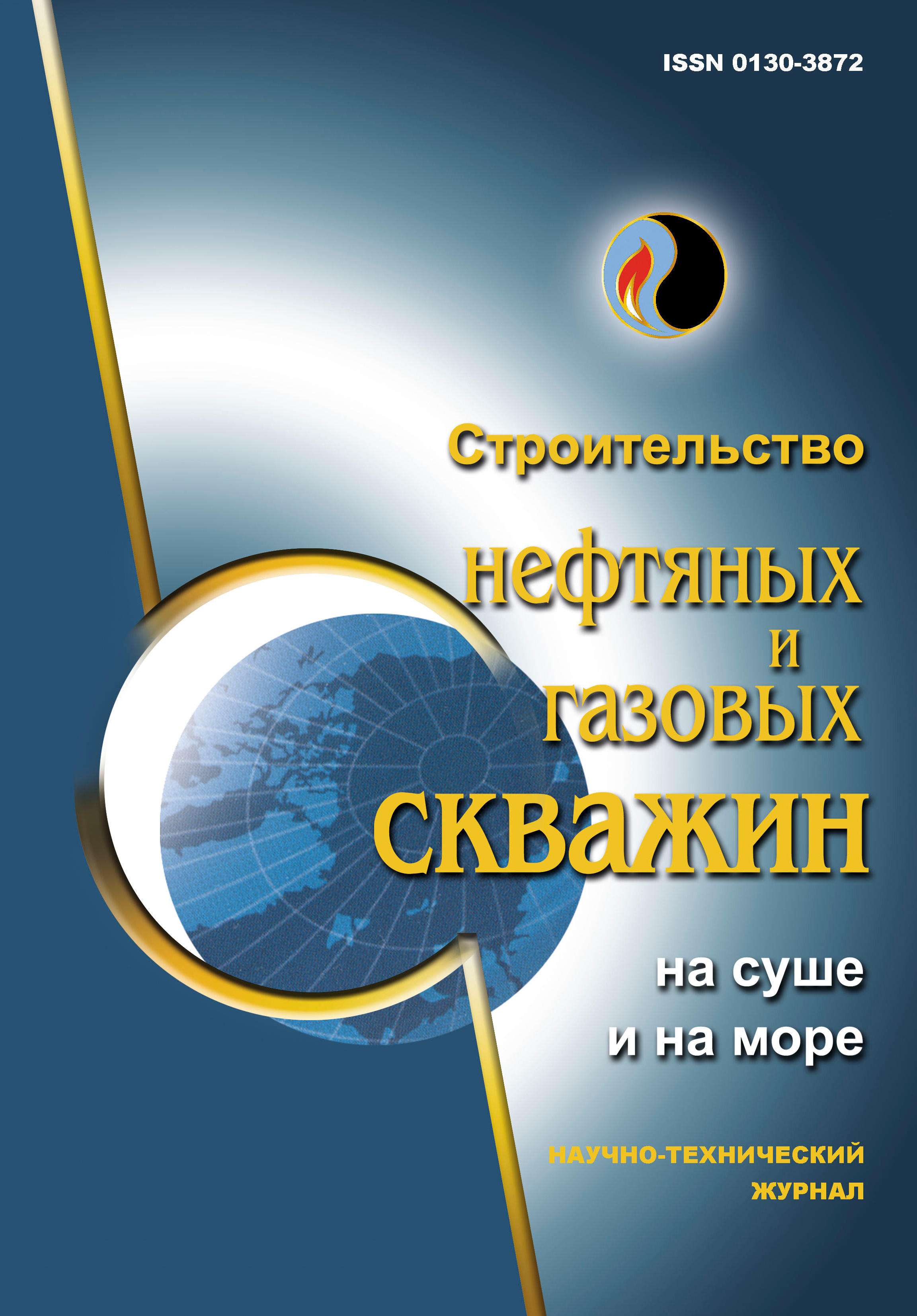Научно-технический журнал
«Onshore and offshore oil and gas well construction»
ISSN 0130-3872

Control of the cement mortar-stone properties to ensure the wells cementing tightness
UDC: 622.245
DOI: 10.33285/0130-3872-2022-3(351)-42-48
Authors:
1 Scientific Research Institute of Pipeline Transport, Moscow, Russian Federation
Keywords: well construction, well cementing, grout cements, cement stone shrinkage, contraction, expanding additives, expansion mechanism, hydrate bonds
Annotation:
In order to ensure the of the well cementingtightness, in addition to solving the problems of controlling the of cement mortarproperties during cementing, it is also necessary to observe the condition for maintaining the technical properties of the cement stone, such as its non-shrinkage, stability of the hydrate structures that make up the stone. The presence of gaps between the cement stone and the surfaces limiting it in the behind and annular spaces to a large extent violates the stability of the cement ring in the behind and annular spaces as an engineering structureelement. Therefore, shrinkage deformations of the cement paste-stone are one of the factors contributing to the formation of leaky annular space of wells. Maintaining the stability of the cement stone technical properties in the annular space of wells is solved mainly by controlling the cement stonecomposition. This allows changing the state and polarity of bonds in the hydrated structure of the cement stone. This technical way is not always feasible due to differences in the thermodynamic conditions for the formation and existence of cement stone in the well. However, it is possible to control the state of bonds in the cement stone by creating inclusion compounds based on water and organic compounds. Strengthening the non-polarity of bonds in the cement stone, created by the formation of hydrated inclusion compounds, is able to control the stability of bonds in the compounds that make up the cement stone. It thus allows controlling its strength properties, volumetric deformations, and operational durability.
Bibliography:
1. Agzamov F.A., Izmukhambetov B.S. Dolgovechnost' tamponazhnogo kamnya v korrozionno-aktivnykh sredakh. – SPb.: Nedra, 2005. – 317 s.2. Gazoproyavleniya v skvazhinakh i bor'ba s nimi / A.I. Bulatov, V.I. Ryabchenko, I.A. Sibirko, N.A. Sidorov. – M.: Nedra, 1969. – 278 s.
3. Bakshutov V.S. Mineralizovannye tamponazhnye rastvory dlya tsementirovaniya skvazhin v slozhnykh usloviyakh. – M.: Nedra, 1986. – 272 s.
4. Bulatov A.I. Sovershenstvovanie gidravlicheskikh metodov tsementirovaniya skvazhin. – M.: Nedra, 1978. – 240 s.
5. Sharafutdinov Z.Z., Chegodaev F.A., Sharafutdinova R.Z. Burovye i tamponazhnye rastvory. Teoriya i praktika: sprav. – SPb.: NPO "Professional", 2007. – 416 s.
6. Danyushevskiy V.S. Proektirovanie optimal'nykh sostavov tamponazhnykh tsementov. – M.: Nedra, 1978. – 293 s.
7. Ratinov V.B., Rozenberg T.I. Dobavki v beton. – M.: Stroyizdat, 1973. – 207 s.
8. Dobavki v beton: sprav. posobie / pod red. V.S. Ramachandrana; per. s angl. T.I. Rozenberg, S.A. Boldyreva. – M.: Stroyizdat, 1988. – 575 s.
9. Dyadin Yu.A., Udachin K.A., Bondaryuk I.V. Soedineniya vklyucheniya. – Novosibirsk: Izd-vo Novosib. gos. un-ta, 1988. – 93 s.
10. Zatsepina G.N. Fizicheskie svoystva i struktura vody. – 2-e izd., pererab. – M.: Izd-vo MGU, 1987. – 171 s.
11. Klyusov A.A. Chastotnaya zavisimost' mezhelektrodnoy emkosti zhidkoy fazy tsementnogo testa // Izv. AN SSSR. Neorganicheskie materialy. – 1983. – T. 19, № 7. – S. 1196–1198.
12. Kreplenie vysokotemperaturnykh skvazhin v korrozionno-aktivnykh sredakh / V.M. Kravtsov, Yu.S. Kuznetsov, M.R. Mavlyutov, F.A. Agzamov. – M.: Nedra, 1987. – 190 s.
13. Kuznetsova T.V. Alyuminatnye i sul'foalyuminatnye tsementy. – M.: Stroyizdat, 1986. – 208 s.
14. Griguletskiy V.G. Opytno-promyshlennye raboty pri tsementirovanii obsadnykh kolonn gazovykh skvazhin Pestsovoy ploshchadi Urengoyskogo mestorozhdeniya // Neftegazovye tekhnologii. – 2007. – № 11. – S. 2–14.
15. Paturoev V.V. Polimerbetony. – M.: Stroyizdat, 1987. – 286 s.
16. Griguletskiy V.G., Petresku V.I. Povyshenie effektivnosti tsementirovaniya obsadnykh kolonn Pestsovoy ploshchadi Urengoyskogo mestorozhdeniya (chast' 1) // Stroitel'stvo neftyanykh i gazovykh skvazhin na sushe i na more. – 2008. – № 1. – S. 40–50.
17. Bulatov A.I., Novokhatskiy D.F. Tamponazhnye shlakovye tsementy i rastvory dlya tsementirovaniya glubokikh skvazhin. – M.: Nedra, 1975. – 224 s.
18. Butt Yu.M., Rashkovich L.N. Tverdenie vyazhushchikh pri povyshennykh temperaturakh. – M.: Stroyizdat, 1965. – 223 s.
19. Teylor Kh.F. Khimiya tsementa: per. s angl. – M.: Mir, 1996. – 560 s.
20. Cherkinskiy Yu.S. Polimertsementnyy beton. – M.: Stroyizdat, 1984. – 213 s.
21. Sharafutdinov Z.Z., Ippolitov V.V. Proryv plastovykh flyuidov cherez zatsementirovannoe prostranstvo i osnovnye puti ego predotvrashcheniya: v 4 ch. // Stroitel'stvo neftyanykh i gazovykh skvazhin na sushe i na more. – 2008. – № 6. – S. 41–46; № 7. – S. 42–49; № 8. – S. 41–44; № 9. – S. 28–31.
22. Sharafutdinov Z.Z., Krylov V.I., Bogdanova Yu.M. Upravlenie protsessami formirovaniya tsementnogo kamnya na osnove predstavleniy supramolekulyarnoy khimii // Burenie i neft'. – 2009. – № 12. – S. 8–10.
23. Sharafutdinov Z.Z., Anosov E.V. Vliyanie otdel'nykh faktorov tekhnologii stroitel'stva skvazhin na proryv plastovykh flyuidov po zatsementirovannomu prostranstvu // Stroitel'stvo neftyanykh i gazovykh skvazhin na sushe i na more. – 2013. – № 8. – S. 28–34.
24. Sharafutdinov Z.Z., Krivoborodov Yu.R. Polimertsementnye sistemy dlya stroitel'stva neftyanykh i gazovykh skvazhin // Stroitel'stvo neftyanykh i gazovykh skvazhin na sushe i na more. – 2017. – № 3. – S. 37–50.
25. Eyzenberg D., Kautsman V. Struktura i svoystva vody. – L.: Gidrometeoizdat, 1975. – 280 s.
26. How to prevent annular gas flow following cementing operations / D. Levine, E. Thomas, H. Bezner, G. Tolle // World Oil. – 1980. – Vol. 191, No. 5. – P. 85.
27. Wojtanowicz A., Manowski W., Nishikawa S. Gas Flow in Wells after Cementing: Final report. – Baton Rouge, Louisiana: Louisiana State University, 2000. – II, 58 p.